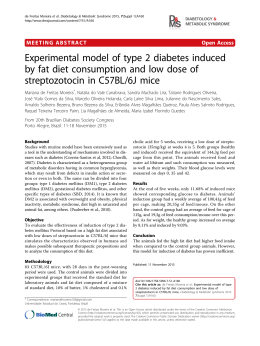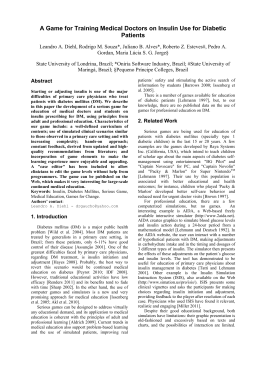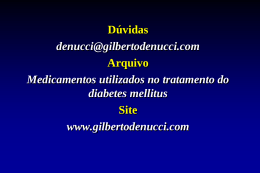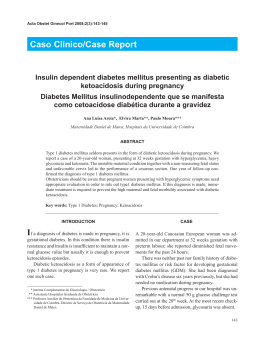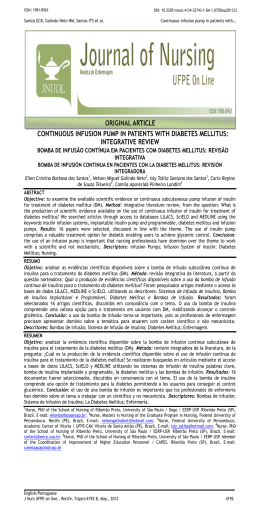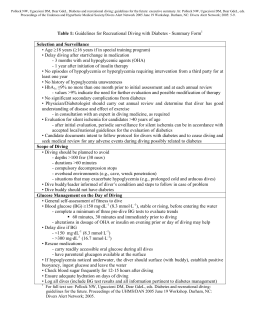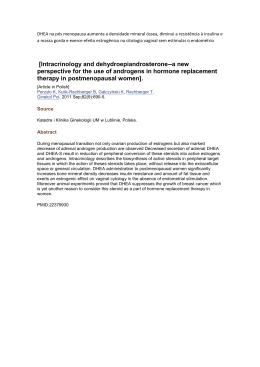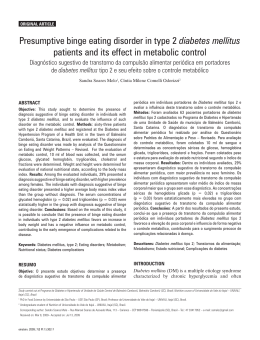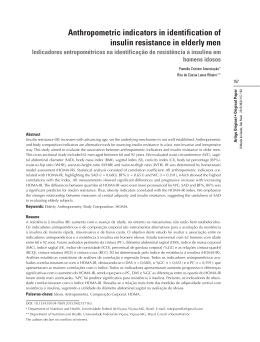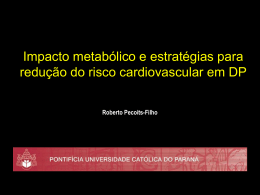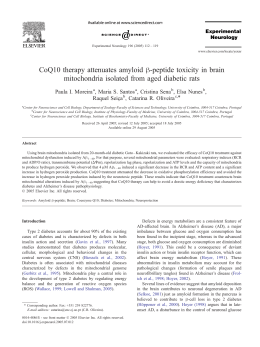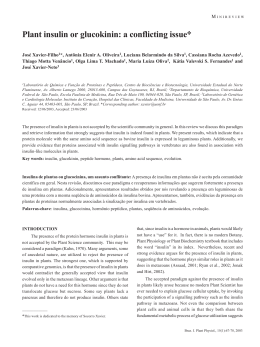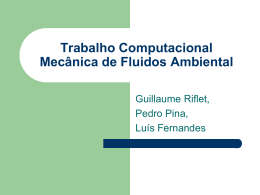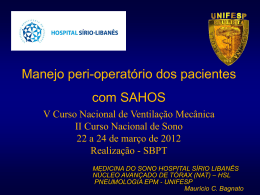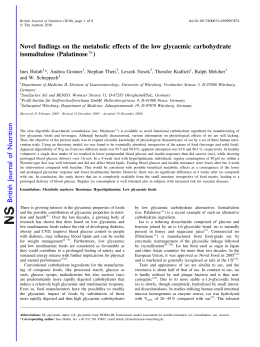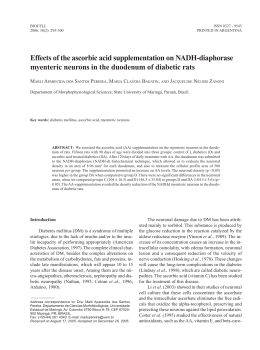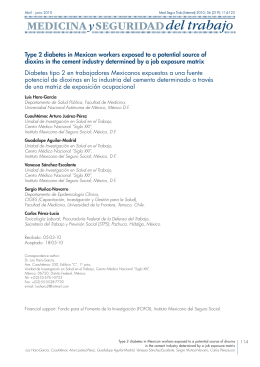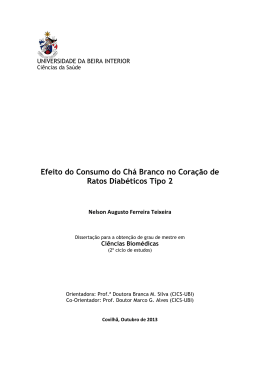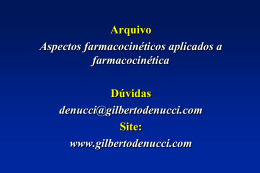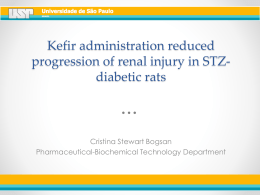Dúvidas [email protected] Arquivo Medicamentos utilizados no tratamento do diabetes mellitus Site www.gilbertodenucci.com Diabetes Mellitus Definição Doença em que o organismo não produz ou utiliza inadequadamente a insulina, o hormônio hipoglicemiante, o que leva a estado de hiperglicemia crônica Glucose tolerance in normal person and in a person with diabetes Guyton & Hall. Textbook of Medical Physiology. Tenth Edition. Principais tipos de Diabetes Mellitus Diabetes Mellitus tipo 1 (juvenil) O DM tipo 1 resulta primariamente da destruição das células pancreáticas tipo beta. Inclui casos decorrentes de doença auto-imune e aqueles nos quais a causa da destruição das células beta não é conhecida Principais tipos de Diabetes Mellitus Diabetes Mellitus tipo 1 (juvenil) • Corresponde a 5-10% do total de casos. A forma rapidamente progressiva é geralmente observada em crianças e adolescentes. A forma lentamente progressiva ocorre geralmente em adultos sendo referida como diabetes latente autoimune do adulto (LADA) Principais tipos de Diabetes Mellitus Diabetes Mellitus tipo 2 (adulto) O DM tipo 2 resulta de graus variáveis de resistência à insulina e deficiência relativa de secreção de insulina. A maioria dos pacientes tem excesso de peso Pathogenesis of type 2 diabetes. The two major metabolic abnormalities, i.e. insulin resistance and insulin deficiency, contribute to hyperglycaemia and result from both genetic and environmental factors. Insulin Resistance GENES Hyperglycaemia ENVIRONMENT Insulin Deficiency Pathophysiology of type 2 diabetes: Rationale for different oral antidiabetic treatment strategies - Diabetes Res Clin Pract. 2005 Jun;68 Suppl1:S22-9. Principais tipos de Diabetes Mellitus Diabetes Mellitus tipo 2 (adulto) Corresponde a 90-95% do total de casos. O diagnóstico é feito geralmente a partir dos 40 anos de idade embora possa ocorrer mais cedo principalmente em associação com a obesidade Diabetes Mellitus tipo 1 x Diabetes Mellitus tipo 2 Tipo 1 Tipo 2 Início < 30 anos > 30 anos História familiar de Diabetes Mellitus Raro Comum Peso corporal Não obeso Obeso Cetoacidose Comum Raro Tratamento com insulina Todos pacientes Alguns pacientes Auto-imunidade Sim Não Prevalência na população adulta 0.5% 5% Associação com HLA Sim Não Clinical Characteristics of Patients with Type I and Type II Diabetes Mellitus Guyton & Hall. Textbook of Medical Physiology. Tenth Edition. Complicações comuns do diabetes tipo 2 Monografia de Glucovance – Site: http://www.merck.com.br/pdf/glucovance_monografia.pdf Intensive glycemic control and risk for microvascular complications Overview of insulin replacement therapy — The Journal of Family Practice - August 2009 (Vol. 58, No. 8) Intensive glycemic control and risk for MI and microvascular complications Overview of insulin replacement therapy — The Journal of Family Practice - August 2009 (Vol. 58, No. 8) Maiores reduções da HbA conferem maior proteção contra as complicações do diabetes Monografia de Glucovance – Site: http://www.merck.com.br/pdf/glucovance_monografia.pdf Effect of removing the pancreas on the approximate concentrations of blood glucose, plasma free fatty acids and acetoacetic acid Guyton & Hall. Textbook of Medical Physiology. Tenth Edition. Insulina Proteína formada por 51 aminoácidos contidos no interior de 2 cadeias peptídicas: uma cadeia A com 21 aminoácidos e uma cadeia B com 30 aminoácidos As cadeias peptídicas são conectadas por duas pontes dissulfeto e, além disso, há uma outra ponte dissulfeto que liga as posições 6 e 11 da cadeia A Insulina Insulina ● = Carbono ● = Oxigênio ● = Nitrogênio, ● = Enxofre Insulina A insulina tende a formar dímeros em solução e hexâmeros na presença do zinco Dímero Hexâmero Hexâmero Insulina Site: http://www.nature.com/nrd/journal/v4/n5/images/nrd1718-f2.jpg Protein Crystal Recombinant Human Insulin Site: http://mix.msfc.nasa.gov/IMAGES/HIGH/9802450.jpg Insulina A insulina endógena circulante tem meia-vida de 3-5 minutos É catabolizada por insulinases no fígado, nos rins e na placenta sendo que cerca de 50% da insulina são removidos em uma única passagem pelo fígado Insulina A insulina é sintetizada nas células pancreáticas tipo beta das ilhotas de Langerhans Insulina Célula pancreática tipo beta Ilhotas de Langerhans Insulina Ilhotas de Langerhans Insulina Forma-se inicialmente um pré-pró-hormônio insulínico Este pré-pró-hormônio é clivado para formar uma próinsulina que, em sua maior parte, é clivada adicionalmente liberando o peptídeo C para formar a insulina Insulina Pró-insulina Peptidases da célula pancreática tipo beta Insulina Peptídeo C livre Insulina Injeção de dextrose intra-peritoneal (5 g/kg) ½ 1 2 3 ½ hora: depleção dos grânulos de insulina na célula tipo beta 4 5 6 Horas 6 horas: restauração dos grânulos de insulina na célula tipo beta Controle da liberação de insulina Transportador de Glicose (1-5) Glucose transporters GLUT 1 Brain, erythrocytes, placenta, fetal tissue Low Km* (~ 1 mM). Allows relatively constant uptake of glucose independent of the normal extracellular concentration (4–6 mM). GLUT 2 Liver, kidney, intestine, pancreatic β-cell. High Km (15–20 mM). Allows intracellular and extracellular glucose to equilibrate across membrane. GLUT 3 Brain Low Km (<1 mM) compared with GLUT2. Allows preferential uptake in hypoglycemia. GLUT 4 Muscle and adipose tissue Medium Km (2.5–5 mM). Insulin recruits transporters from intracellular stores increasing glucose uptake. GLUT 5 Jejunum Medium Km (~ 6 mM). Responsible for fructose uptake. Transportadores da glicose em humanos GLUT-1 GLUT-2 GLUT-3 Todos os tecidos Captação basal de glicose Fígado e células pancreáticas tipo beta Captação de glicose na hiperglicemia Todos os tecidos Captação basal de glicose GLUT-4 Músculo esquelético e tecido adiposo Captação de glicose dependente de insulina GLUT-5 Intestino delgado e espermatozóides Transportador de frutose Aspectos anatômicos da ilhota de Langerhans Ação da Insulina Captação de glicose Insulina Fosforilação Fusão GLUT-4 Translocação Effect of insulin in enhancing the concentration of glucose inside muscle cells Guyton & Hall. Textbook of Medical Physiology. Tenth Edition. Schematic of the insulin receptor Guyton & Hall. Textbook of Medical Physiology. Tenth Edition. The actions of insulin and glucagon in liver, muscle and adipose tissue on the overall flow of fuels http://www.ncbi.nlm.nih.gov/books/bv Efeitos da insulina no metabolismo Carboidratos Aumenta o transporte de glicose Aumenta a síntese de glicogênio Inibe a glicogenólise Inibe a gliconeogênese Lipídeos Aumenta a atividade da lipoproteína lipase Aumenta o armazenamento de gordura nos adipócitos Aumenta a síntese de lipoproteínas no fígado Inibe a lipólise Inibe a oxidação de ácidos graxos Proteínas Aumenta o transporte de aminoácidos Aumenta a síntese de proteínas Insulinas de Mamíferos Rapid-acting analogue (clear) • • • • • Onset: 10–15 min Peak: 60–90 min Duration: 4– 5 h Humalog® (insulin lispro) NovoRapid® (insulin aspart) Insulin LisPro Insulina Lispro e Aspart Fast-acting (clear) • • • • • Onset: 0.5–1 h Peak: 2–4 h Duration: 5–8 h Humulin®-R Novolin®ge Toronto Intermediate-acting (cloudy) • • • • • • Onset: 1–3 h Peak: 5–8 h Duration: up to 18 h Humulin®-N Humulin®-L Novolin®ge NPH Long-acting (cloudy) • • • • Onset: 3–4 h Peak: 8–15 h Duration: 22–26 h Humulin®-U Extended long-acting analogue • Onset: 90 min • Duration:24 h • Lantus®* (insulin glargine) Insulina Glarginina (Lantus) Premixed (cloudy) • A single vial contains a fixed ratio of insulin (% rapid- or fast-acting to % intermediateacting insulin) • Humalog® Mix25TM • Humulin® (20/80, 30/70) • Novolin®ge (10/90, 20/80, 30/70, 40/60, 50/50) Terapia com insulina Insulina plasmática em não diabéticos µU/mL 40 30 20 10 0 Glicemia em não diabéticos mg/dL 120 100 80 8am 10 12 2pm 4 6 Desjejum Almoço 8 10 12 2am 4 Jantar Lanche 6 8am Terapia com insulina Regime misto NPH Regular NPH + Regular NPH + Regular Insulina Ultralente Regular Ultralente 8am 10 12 2pm 4 6 Ultralente + Regular Regular 8 10 12 2am 4 Regular 6 8am Pacientes em uso de CSII nos EUA 1400000 1200000 1200000 1000000 800000 600000 400000 200000 6600 8700 11400 15000 20000 1990 1991 1992 1993 1994 42000 60000 100000 35000 81000 26500 1995 1996 1997 1998 1999 2000 0 Ano 2012 Controle de glicemia em uso de CSII n Idade média (anos ± DP) HbA1c* préCSII (%) HbA1c* pósCSII (%) P Folow-up (meses) 143 34 ± 13 8.28 7.46 <0.001 42 Bode (adolescentes) 50 14.9 ± 2.6 9.64 8.24 <0.001 42 Rudolph and Hirsch 107 36 ± 10.4 7.6 7.1 <0.0001 36 Chanteleau 116 29 ± 1 7.7 6.7 <0.001 54 Roland 25 13.8 ± 2.1 8.4 7.5 0.02 12 Autores Bode (adultos) * mg/dL Controle de glicemia: adolescentes x adultos 10 9 HbA1c (%) 9.64 * 8.24 8.28 * 7.46 8 7 6 Adolescentes n = 50 Adultos n=413 Pré-CSII Pós-CSII * P < 0.001 Hipoglicemia pré e pós CSII n Idade média (anos ± DP) Hipoglicemia pré-CSII (%) Hipoglicemia pós-CSII (%) P 55 39.2 ± 12.9 138 22 <0.0001 Rudolph and Hirsch 107 36 ± 10.4 73.2 19.2 <0.0001 Chanteleau 116 29 ± 1 ND 10 25 13.8 ± 2.1 134 76 Autores Bode Roland ND – Não disponível 0.01 Hipoglicemia pré e pós CSII 150 138 100 39 50 0 22 Pré CSII 1 ano 36 26 2 anos 3 anos -------------------CSII---------------- 4 anos Redução no número de episódios de cetoacidose após uso de CSII 0,5 0,4 Eventos por ano 0,3 0,3 0,2 0,1 0,1 0,1 0 * P < 0.001 * 0,01 Adolescentes n = 43 Pré-CSII Adultos n = 229 Pós-CSII Inhaled Insulin Device. The Exubera inhaled insulin device is closed for portability and opened before use. It is activated after insertion of an insulin blister. The release unit must be changed every 2 weeks. Exubera Action of insulin on the adipocyte The effects of insulin on adipose tissue. http://www.ncbi.nlm.nih.gov/books/bv Sulfoniluréias Sulfoniluréias (clorpropamida, glipizida, gliclazida e glimepirida) glibenclamida, Estimulam a secreção de insulina ligando-se a um receptor específico na célula beta o qual determina o fechamento dos canais de potássio dependentes de ATP resultando em despolarização da célula Controle da liberação de insulina Chlorpropamide (t ½ = 36 h) (1st generation) Site: http://en.wikipedia.org/wiki/File:Chlorpropamide.svg Gliclazide (t ½ = 10 h) (1st generation) Site: http://en.wikipedia.org/wiki/File:Gliclazide.svg Tolbutamide (t ½ = 4.5-6.5 h) (1st generation) Site: http://en.wikipedia.org/wiki/File:Tolbutamide.svg Glibenclamide (t ½ = 10h) (2st generation) Site: http://en.wikipedia.org/wiki/File:Glibenclamide.svg Glipizide ( t ½ = 2-4 hs) (2st generation) Site: http://en.wikipedia.org/wiki/File:Glipizide.svg Glimepiride (t ½ = 5 h) (3st generation) Site: http://en.wikipedia.org/wiki/File:Glimepiride.svg Meglitinidas Derivados do ácido benzóico (repaglinida) Derivados da d-fenilalanina (nateglinida) Estimulam a secreção de insulina ligando-se a receptores na célula beta em sítios distintos dos canais de potássio dependentes de ATP. Controle da liberação de insulina Repaglinide Nateglinide Metformin Biguanides Suggested mode action: Reduces hepatic glucose production and glycogen metabolism Improves insulin resistance via enhancing insulin-mediated glucose uptake by skeletal muscle Lowers triglycerides and total cholesterol levels Raises high-density lipoprotein (HDL) levels and causes weight loss Metformin Helpful in stabilizing blood sugar in brittle diabetics on insulin therapy Indicated alone in obese, mild diabetics because, unlike insulin, it does not enhance lipogenesis Glucose Glucose-PO4 Lipogenesis Krebs cycle Blood Glucose, mg/100ml Inhibition of oxidative metabolism Lactic acid Blood glucose (diabetic) 100 Blood glucose (nondiabetic) 15 Blood insulin Hours 0 1 2 3 Insulin Microunits/ml Pyruvic acid Administration 200 Mechanisms of action of metformin. Metformin Phosphorylation / Activation of AMP Kinase ↓ SREBP-1 Expression/Activuty ↓ ACC Activity ↓ Hepatic Gene Expression (e.g., FAS) ↑ Muscle Glucose Transport ↓ Hepatic FA and VLDL Synthesis (↑ Hepatic FA Oxidation) ↓ Hepatic Steatosis ↑ Hepatic Insulin Sensitivity ↓ Hepatic Glucose Production ↓ Plasma Glucose and Triglycerides The major target of metformin is the enzyme AMP-activated protein kinase (AMP kinase). Activation of AMP kinase by metformin results in decreased SREBP-1 expression in the liver, with consequent reduced expression of enzymes regulating FA synthesis, including fatty acid synthase (FAS), and inhibition of acetyl-CoA carboxylase (ACC) activity, also leading to decreased FA synthesis. Furthermore, AMP kinase activation results in decreased hepatic glucose production and increased glucose transport in skeletal muscle. The overall effect is to decrease glucose and triglyceride levels, particularly in the post-absorptive state. FA, fatty acid; SREBP, sterol regulatory elementbinding protein 1. Pathophysiology of type 2 diabetes: Rationale for different oral antidiabetic treatment strategies - Diabetes Res Clin Pract. 2005 Jun;68 Suppl1:S22-9. Tiazolidinedionas • • • • Reduz glicose plasmática Aumenta uptake periférico de glicose Reduz níveis de triglicerídeos Aumenta a sensibilidade à insulina em tecidos periféricos Tiazolidinedionas • Troglitazona (retirada do mercado) • Rosiglitazona (retirada do mercado) • Pioglitazona Thiazolidinedione Site: http://en.wikipedia.org/wiki/File:Thiazolidinedione.png Pioglitazone Site: http://www.dalton.com/images/pioglitazone.gif Peroxisome proliferator-activated receptor (PPAR) α (alpha) - liver, kidney, heart, muscle, adipose tissue and others β/δ (beta/delta) - expressed in many tissues but markedly in brain, adipose tissue and skin γ (gamma) - although transcribed by the same gene, this PPAR through alternative splicing is expressed in three forms: • γ1 - expressed in virtually all tissues, including heart, muscle, colon, kidney, pancreas, and spleen • γ2 - expressed mainly in adipose tissue (30 amino acids longer) • γ3 - expressed in macrophages, large intestine, white adipos tissue. Alternative splicing resulting in protein isoforms Site: http://en.wikipedia.org/wiki/File:Splicing_overview.jpg Peroxisome proliferator - activated receptor pathway diagram Site: http://en.wikipedia.org/wiki/File:PPAR-diagram.png Thiazolidinediones Bioactive GLP-1(7-36)amide and GIP (1-42) are released from the small intestine after meal ingestion and enhance glucose stimulated insulin secretion (incretin action). DPP-4 rapidly converts GLP-1 and GIP to their inactive metabolites GLP-1 (9-36) and GIP (3-42) in vivo. Inhibition of DPP-4 activity prevents GLP-1 and GIP degradation, thereby enhancing incretin action. Biology of Incretins: GLP-1 and GIP - GASTROENTEROLOGY 2007;132:2131–2157 GIP actions in peripheral tissues. Biology of Incretins: GLP-1 and GIP - GASTROENTEROLOGY 2007;132:2131–2157 Exenatide (Byetta) • • • • • • 53% idêntico ao GLP-1 Resistente a DPP-IV Aumenta a secreção de insulina Reduz a secreção de glucagon Aumenta o tempo de esvaziamento gástrico Sensação de saciedade – provoca queda de peso GLP-1 actions in peripheral tissues. The majority of the effects of GLP-1 are mediated by direct interaction with GLP-1Rs on specific tissues. However, the actions of GLP-1 in liver, fat, and muscle most likely occur through indirect mechanisms. Biology of Incretins: GLP-1 and GIP - GASTROENTEROLOGY 2007;132:2131–2157 The inactivation process of GLP-1 by DPP-IV. GLP-1 based therapy for type 2 diabetes - european journal of pharmaceutical sciences 2 8 ( 2 0 0 6 ) 96–1081 Saxagliptin Site: http://en.wikipedia.org/wiki/File:Saxagliptin.svg Sitagliptin Site: http://en.wikipedia.org/wiki/File:Sitagliptin.svg Vildagliptin Site: http://en.wikipedia.org/wiki/File:Vildagliptin_Structural_Formulae.png Mechanism of action of vildagliptin. In response to a meal, active glucagonlike peptide-1 (GLP-1) is secreted by the L cells of the intestines. Without the presence of vildagliptin, GLP-1 is rapidly inactivated and degraded by the enzyme dipeptidyl peptidase IV (DPP4); when vildagliptin is present, vildagliptin binds to DPP4, allowing GLP-1 to remain active. Active GLP-1 causes the pancreas to increase insulin release and decrease glucagon release. Vildagliptin: A novel oral therapy for type 2 diabetes mellitus - Am J Health-Syst Pharm—Vol 64 Jun 15, 2007 Target 2 physiologic glucose-lowering actions with a single oral agent Glucose-dependent mechanism target 2 key defects: insulin release and hepatic glucose production Site: www.januvia.com In a single-dose pharmacokinetic study of patients with type 2 diabetes Rapidly increased active incretins (GLP-1 and GIP) through a full 24 hours Site: www.januvia.com A single oral dose sustains powerful DPP-4 inhibition for a full 24 hours Site: www.januvia.com Significantly improved key meassures of beta-cell and alpha-cell responsiveness to glucose Site: www.januvia.com Amylin 37 amino acid compound Co-secreted with insulin from beta cells Deficient in type 1 and type 2 DM Renal clearance Amylin - Physiological effects 1. Suppression of endogenous glucagon production (especially in the postprandial state) 2. Reduction in postprandial hepatic glucose production 3. Reduction in gastric emptying time 4. Centrally mediated induction of satiety 5. Reduction in postprandial glucose levels Pramlintide Synthetic analogue of Amylin (3 amino acid substitutions with proline for native amino acids) Subcutaneous administration Pramlintide The most commonly reported adverse effects associated with pramlintide use in type 1 DM were nausea, anorexia, and hypoglycemia in these studies. Acarbose É um inibidor competitivo de α-glicosidases intestinais tais como maltase, isomaltase, sacarase e glicoamilase, retardando a absorção de carboidratos Forest plot of comparison: colesevelam vs. placebo, outcome: mean change in fasting blood glucose from baseline to endpoint (mmol/l). Systematic Review or Meta-analysis Colesevelam for Type 2 diabetes mellitus: an abridged Cochrane review - DIABETICMedicine DOI: 10.1111/dme.12295 – Fig 04 Forest plot of comparison: 1 colesevelam vs. placebo, outcome: 1.4 mean change in HbA1c from baseline to endpoint (%). Systematic Review or Meta-analysis Colesevelam for Type 2 diabetes mellitus: an abridged Cochrane review - DIABETICMedicine DOI: 10.1111/dme.12295 – Fig 05 Forest plot of comparison: colesevelam vs. placebo, outcome: adverse events. M-H, Mantel-Haenszel. Systematic Review or Meta-analysis Colesevelam for Type 2 diabetes mellitus: an abridged Cochrane review - DIABETICMedicine DOI: 10.1111/dme.12295 – Fig 06 Forest plot of comparison: 1 colesevelam vs. placebo, outcome: 1.5 mean change in LDL cholesterol from baseline to endpoints (mmol/l). Systematic Review or Meta-analysis Colesevelam for Type 2 diabetes mellitus: an abridged Cochrane review - DIABETICMedicine DOI: 10.1111/dme.12295 – Fig 07 Chemical Structure of Canagliflozin Canagliflozin For The Treatment of Type 2 Diabetes Drugs Today 2013, 49(6):363-376. fig 01 Renal glucose transport Both SGLT1 and SGLT2 reabsorb the filtered glucose, although the majority of glucose is reabsorbed by SGLT2 Clinical potential of sodium-glucose cotransporter 2 inhibitors in the management of type 2 diabetes - Diabetes, Metabolic Syndrome and Obesity: Targets and Therapy 2012:5 313–327 – Fig 01 At plasma glucose concentration around 8.3 mmol/liter, glucose appears in the urine. After the saturation threshold of 13.3 mmol/liter, glucosuria increases linearly along with plasma glucose. SGLT2 inhibition promotes glucosuria at an earlier saturation threshold, permitting less reabsorption of glucose. Clinical potential of sodium-glucose cotransporter 2 inhibitors in the management of type 2 diabetes - Diabetes, Metabolic Syndrome and Obesity: Targets and Therapy 2012:5 313–327 – Fig 02 Change from baseline in A1c, percentage fasting plasma glucose concentration, and total body weight in dapagliflozin 2.5, 5 and 10 mg and placebo groups up to week 24. Clinical potential of sodium-glucose cotransporter 2 inhibitors in the management of type 2 diabetes - Diabetes, Metabolic Syndrome and Obesity: Targets and Therapy 2012:5 313–327 – Fig 03 Change from baseline in A1c, percentage fasting plasma glucose concentration, and total body weight in dapagliflozin 2.5, 5 and 10 mg and placebo groups up to week 24. Clinical potential of sodium-glucose cotransporter 2 inhibitors in the management of type 2 diabetes - Diabetes, Metabolic Syndrome and Obesity: Targets and Therapy 2012:5 313–327 – Fig 03 Change from baseline in A1c, percentage fasting plasma glucose concentration, and total body weight in dapagliflozin 2.5, 5 and 10 mg and placebo groups up to week 24. Clinical potential of sodium-glucose cotransporter 2 inhibitors in the management of type 2 diabetes - Diabetes, Metabolic Syndrome and Obesity: Targets and Therapy 2012:5 313–327 – Fig 03 A and B) Change in body mass component as measured by dual-energy X-ray absorptiometer fat mass and lean mass and Visceral Adipose Tissue (VAT) and Subcutaneous Adipose Tissue (SAT) volume as measured by magnetic resonance substudy, in type 2 diabetes patients inadequately controlled on metformin, randomized to dapagliflozin versus placebo. Clinical potential of sodium-glucose cotransporter 2 inhibitors in the management of type 2 diabetes - Diabetes, Metabolic Syndrome and Obesity: Targets and Therapy 2012:5 313–327 – Fig 04 (A and B) Change in A1c and body weight over a 52 week trial of type 2 diabetes patients uncontrolled on metformin randomized to glipizide versus dapagliflozin Clinical potential of sodium-glucose cotransporter 2 inhibitors in the management of type 2 diabetes - Diabetes, Metabolic Syndrome and Obesity: Targets and Therapy 2012:5 313–327 – Fig 05 (A–C) Mean A1c, Fasting Plasma Glucose (FPG) and change in body weight from baseline over 12 weeks in patients with type 2 diabetes receiving insulin plus insulin sensitizers, randomized to dapagliflozin versus placebo. Clinical potential of sodium-glucose cotransporter 2 inhibitors in the management of type 2 diabetes - Diabetes, Metabolic Syndrome and Obesity: Targets and Therapy 2012:5 313–327 – Fig 06 Efficacy of dapagliflozin in various studies Clinical potential of sodium-glucose cotransporter 2 inhibitors in the management of type 2 diabetes - Diabetes, Metabolic Syndrome and Obesity: Targets and Therapy 2012:5 313–327 – Tablr 01 Mechanisms underlying the putative cardiovascular effects of incretinbased therapies The cardiovascular safety of incretin-based therapies: a review of the evidence - Petrie Cardiovascular Diabetology 2013, 12:130 – Fig 01 Mean weight loss in clinical trials with anti-obesity drugs Do we need anti-obesity drugs? - Diabetes Metab Res Rev 2012; 28(Suppl 2): 8–20. – Table 01 Antidiabetogenic effects of GLP-1 GLP-1 based therapy for type 2 diabetes - european journal of pharmaceutical sciences 2 8 ( 2 0 0 6 ) 96–1081 Potency and selectivity of some DPP-IV inhibitors GLP-1 based therapy for type 2 diabetes - european journal of pharmaceutical sciences 2 8 ( 2 0 0 6 ) 96–1081 Physiological processes modulated by DPP-IV activity GLP-1 based therapy for type 2 diabetes - european journal of pharmaceutical sciences 2 8 ( 2 0 0 6 ) 96–1081 The family of glucose transporters (GLUTs 1–5) http://www.ncbi.nlm.nih.gov/books/bv Therapies for DM - 1 Human insulin replacement http://www.ncbi.nlm.nih.gov/books/bv Therapies for DM - 1 Human insulin replacement http://www.ncbi.nlm.nih.gov/books/bv Bariatric Surgery and Prevention of Type 2 Diabetes in Swedish Obese Subjects ABSTRACT BACKGROUND Weight loss protects against type 2 diabetes but is hard to maintain with behavioral modification alone. In an analysis of data from a nonrandomized, prospective, controlled study, we examined the effects of bariatric surgery on the prevention of type 2 diabetes. n engl j med 367;8 nejm.org august 23, 2012 Bariatric Surgery and Prevention of Type 2 Diabetes in Swedish Obese Subjects ABSTRACT METHODS In this analysis, we included 1658 patients who underwent bariatric surgery and 1771 obese matched controls (with matching performed on a group, rather than individual, level). None of the participants had diabetes at baseline. Patients in the bariatric-surgery cohort underwent banding (19%), vertical banded gastroplasty (69%), or gastric bypass (12%); nonrandomized, matched, prospective controls received usual care. Participants were 37 to 60 years of age, and the body-mass index (BMI; the weight in kilograms divided by the square of the height in meters) was 34 or more in men and 38 or more in women. This analysis focused on the rate of incident type 2 diabetes, which was a prespecified secondary end point in the main study. At the time of this analysis (January 1, 2012), participants had been followed for up to 15 years. Despite matching, some baseline characteristics differed significantly between the groups; the baseline body weight was higher and risk factors were more pronounced in the bariatric-surgery group than in the control group. At 15 years, 36.2% of the original participants had dropped out of the study, and 30.9% had not yet reached the time for their 15-year follow-up examination. n engl j med 367;8 nejm.org august 23, 2012 Bariatric Surgery and Prevention of Type 2 Diabetes in Swedish Obese Subjects ABSTRACT RESULTS During the follow-up period, type 2 diabetes developed in 392 participants in the control group and in 110 in the bariatric-surgery group, corresponding to incidence rates of 28.4 cases per 1000 person-years and 6.8 cases per 1000 person-years, respectively (adjusted hazard ratio with bariatric surgery, 0.17; 95% confidence interval, 0.13 to 0.21; P<0.001). The effect of bariatric surgery was influenced by the presence or absence of impaired fasting glucose (P = 0.002 for the interaction) but not by BMI (P = 0.54). Sensitivity analyses, including end-point imputations, did not change the overall conclusions. The postoperative mortality was 0.2%, and 2.8% of patients who underwent bariatric surgery required reoperation within 90 days owing to complications. n engl j med 367;8 nejm.org august 23, 2012 Bariatric Surgery and Prevention of Type 2 Diabetes in Swedish Obese Subjects ABSTRACT CONCLUSIONS Bariatric surgery appears to be markedly more efficient than usual care in the prevention of type 2 diabetes in obese persons. (Funded by the Swedish Research Council and others; ClinicalTrials.gov number, NCT01479452.) n engl j med 367;8 nejm.org august 23, 2012 Natural history of type 2 diabetes (A) Elevations above normal in postmeal and fasting glucose concentrations over time and (B) progression from compensatory bcell function to b-cell decline and failure, leading to a decline in insulin concentrations and insulin resistance. Zero indicates time of diagnosis; dotted lines indicate (A) normal glucose concentrations and (B) 100% b cell function. Choice of early treatment regimen and impact on b-cell preservation in type 2 diabetes - Int J Clin Pract, September 2013, 67, 9, 876–887 – Fig. 01 Bariatric Surgery versus Intensive Medical Therapy in Obese Patients with Diabetes ABSTR ACT Background Observational studies have shown improvement in patients with type 2 diabetes mellitus after bariatric surgery. Methods In this randomized, nonblinded, single-center trial, we evaluated the efficacy of intensive medical therapy alone versus medical therapy plus Roux-en-Y gastric bypass or sleeve gastrectomy in 150 obese patients with uncontrolled type 2 diabetes. The mean (±SD) age of the patients was 49±8 years, and 66% were women. The average glycated hemoglobin level was 9.2±1.5%. The primary end point was the proportion of patients with a glycated hemoglobin level of 6.0% or less 12 months after treatment. Bariatric Surgery versus Intensive Medical Therapy in Obese Patients with Diabetes ABSTR ACT Results Of the 150 patients, 93% completed 12 months of follow-up. The proportion of patients with the primary end point was 12% (5 of 41 patients) in the medicaltherapy group versus 42% (21 of 50 patients) in the gastric-bypass group (P = 0.002) and 37% (18 of 49 patients) in the sleeve-gastrectomy group (P = 0.008). Glycemic control improved in all three groups, with a mean glycated hemoglobin level of 7.5±1.8% in the medical-therapy group, 6.4±0.9% in the gastric-bypass group (P<0.001), and 6.6±1.0% in the sleeve-gastrectomy group (P = 0.003). Weight loss was greater in the gastric-bypass group and sleeve-gastrectomy group (−29.4±9.0 kg and −25.1±8.5 kg, respectively) than in the medical-therapy group (−5.4±8.0 kg) (P<0.001 for both comparisons). The use of drugs to lower glucose, lipid, and blood-pressure levels decreased significantly after both surgical procedures but increased in patients receiving medical therapy only. The index for homeostasis model assessment of insulin resistance (HOMA-IR) improved significantly after bariatric surgery. Four patients underwent reoperation. There were no deaths or life-threatening complications. Bariatric Surgery versus Intensive Medical Therapy in Obese Patients with Diabetes ABSTR ACT Conclusions In obese patients with uncontrolled type 2 diabetes, 12 months of medical therapy plus bariatric surgery achieved glycemic control in significantly more patients than medical therapy alone. Further study will be necessary to assess the durability of these results. (Funded by Ethicon Endo-Surgery and others; ClinicalTrials.gov number, NCT00432809.)
Download
